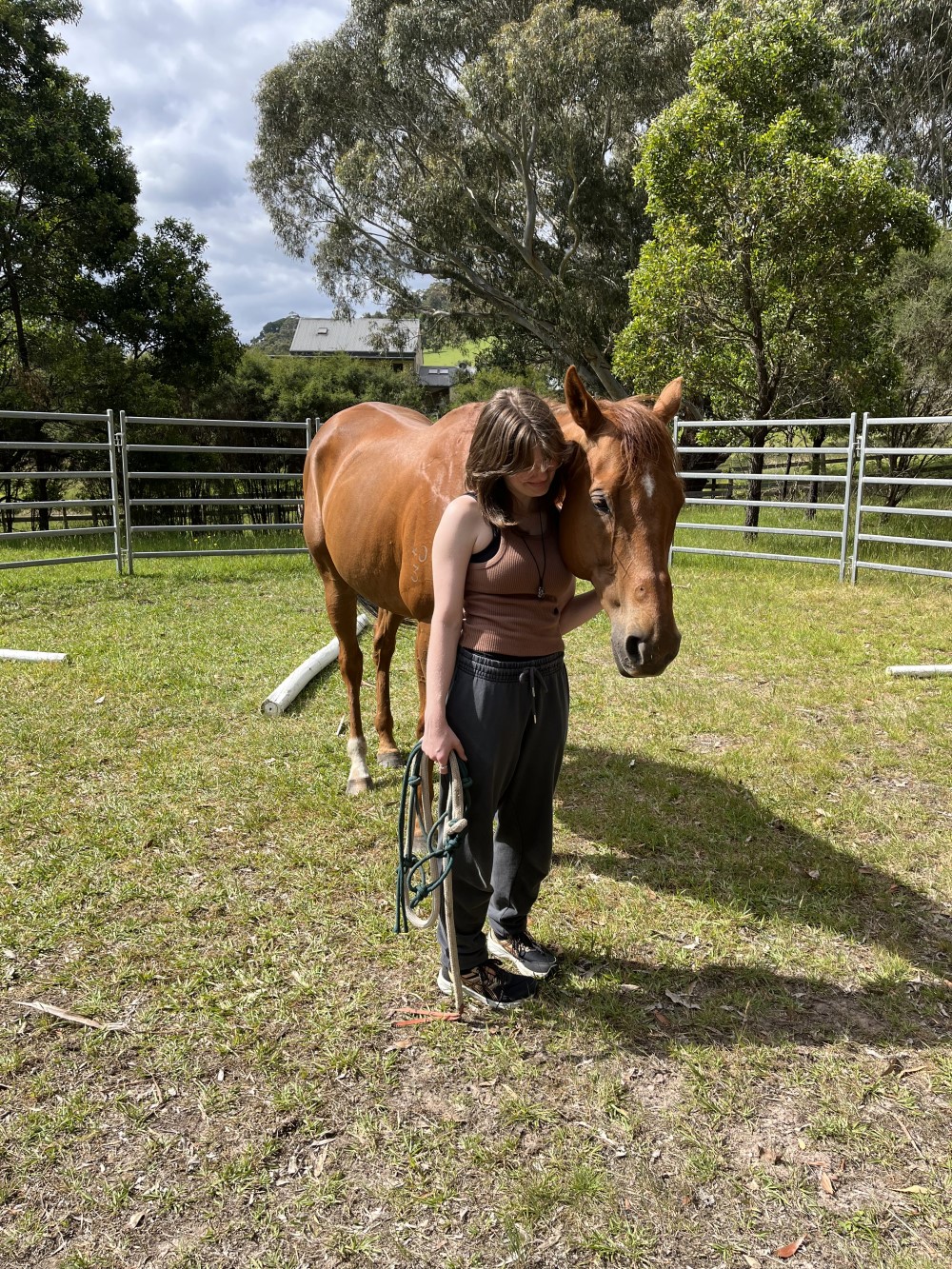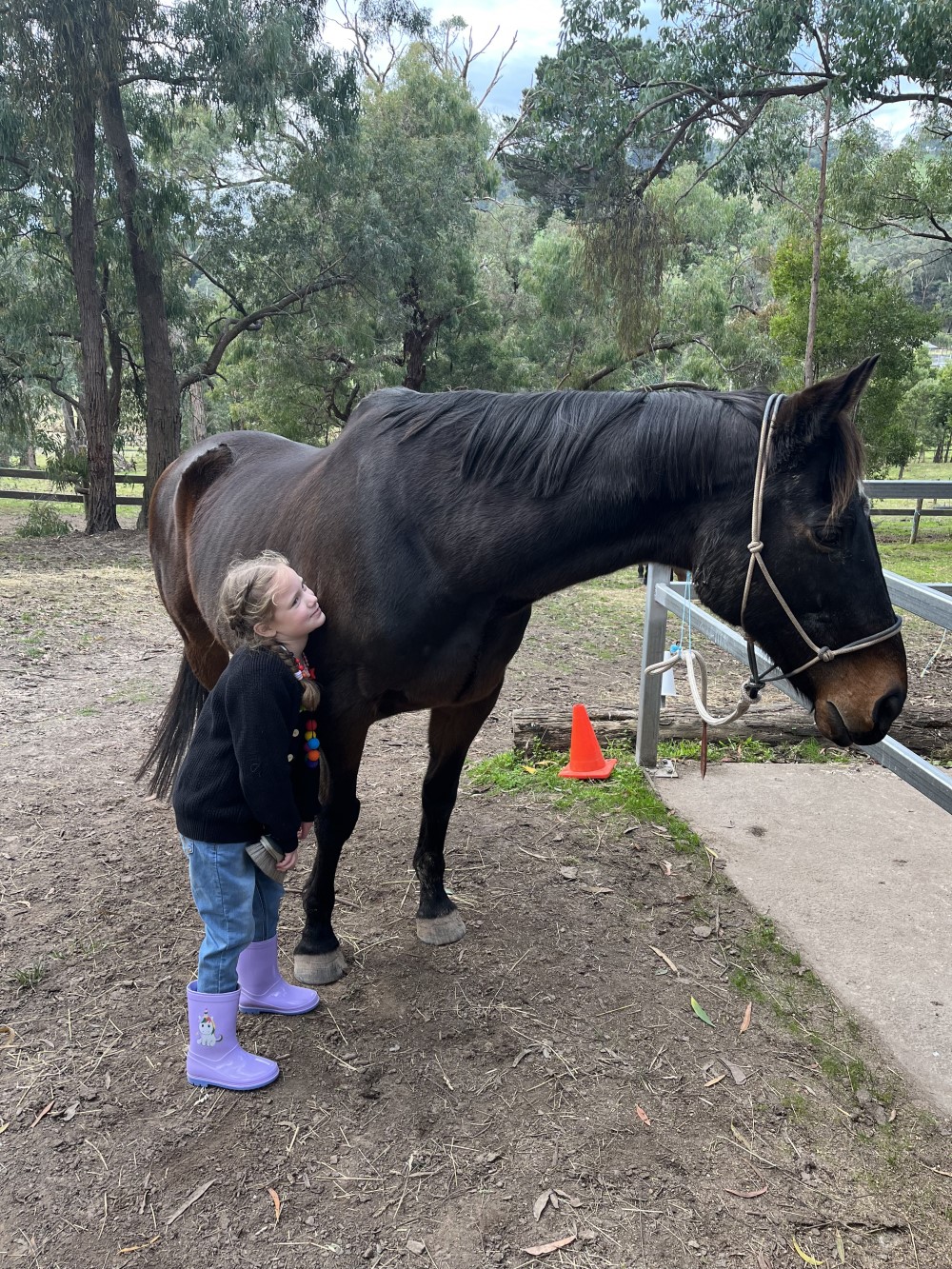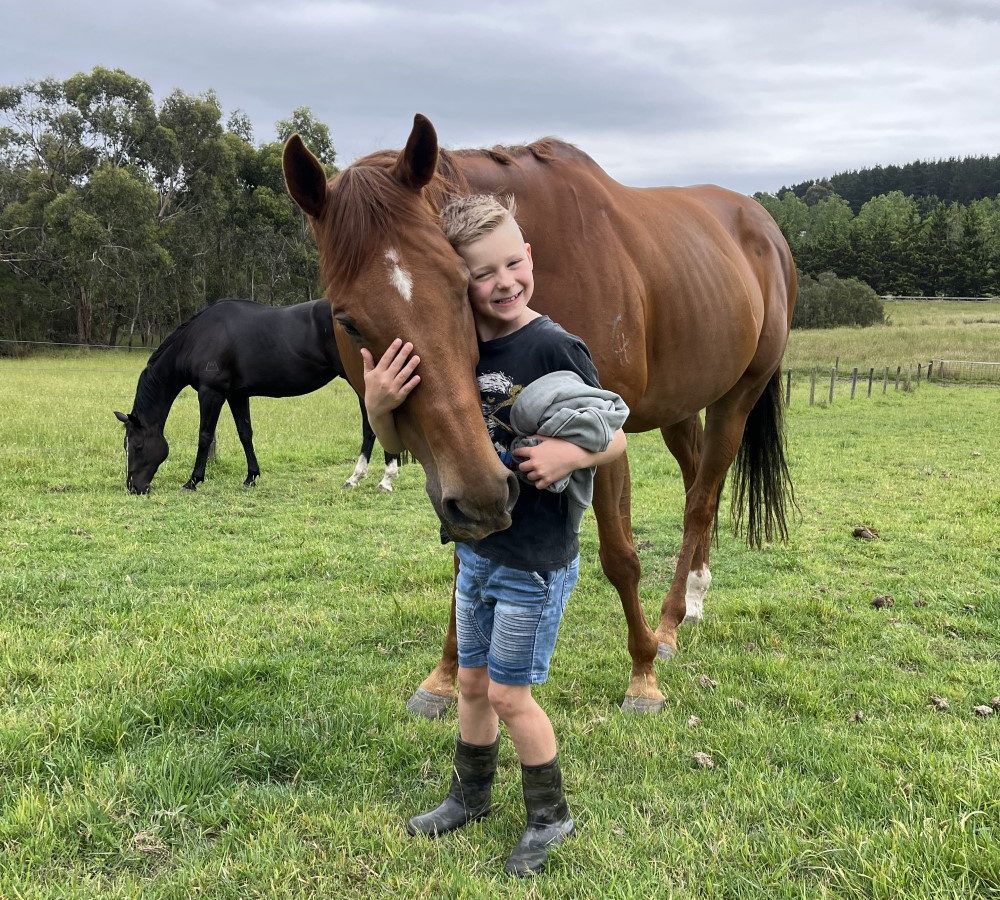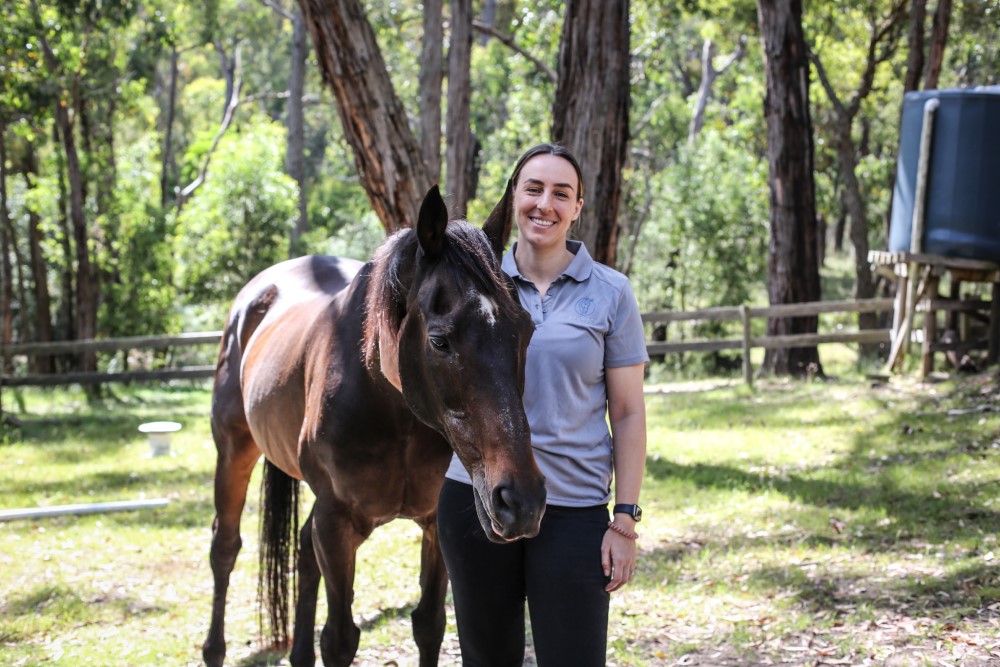It was once Hannah Lloyd’s pipe dream to merge her career with her love of horses. As it turns out, occupational therapy and horses go hand-in-hand – and it benefits not only clients, but also the equine practitioners.
Those who spend time with horses know the feeling of calm they can evoke; pricked ears welcoming you over a stable door, the cathartic repetition of a brush across a gleaming coat, that familiar scent that brings about a sense of stillness.
We also know that horses don’t lie; their feedback is immediate and as American horse trainer Buck Brannaman once said, “The horse is a mirror to your soul. Sometimes you might not like what you see. Sometimes you will.”
As someone who has loved horses all her life, Hannah Lloyd has long known about the benefits our equine friends have to offer. When she undertook her Occupational Therapy (OT) degree, Hannah always had in the back of her mind that she’d love to incorporate working with horses and children – even though initially she considered it “a pipe dream”.

Keen to first equip herself with the grounding principles of OT, Hannah began her career in private practice, working in paediatrics. “I then connected with an equine facilitated learning practitioner, and I saw this avenue was really viable,” she explains. “There was a lot of value in that line of work.”
Working in private practice for several years, she undertook an equine facilitated learning course during that time. This gave Hannah the confidence to merge her OT career with horses, and she began contract work for other practitioners in the field. “I started working at Rehab4Rehab (equine assisted therapy), which was focused on mental health. That was a really great foundation.”
Starting Equinect Therapies in 2022, Hannah’s pipe dream became a reality. “There are a lot of exercises we can do with horses from an OT perspective. As an OT in paediatrics, you can work on core skills, such as fine motor skills, gross motor skills, and sensory processing. However, where horses really shine, and what I’ve focused on, is emotional regulation, anxiety management, and social and emotional skills.”
IMMEDIATE FEEDBACK
Hannah explains that the majority of her clients have an Autism Spectrum Disorder (ASD) diagnosis, while others face anxiety-based challenges. “Social skills and emotional regulation can present challenges for a lot of people with ASD, especially clients that access my services; emotional regulation at home and at school is often their first concern.
“From an OT perspective, we either work on a skill itself or we work on all the little skills that build up to that skill. In the case of emotional regulation, we might work on strategies such as breathing techniques, and how one’s body feels when that happens. All these little skills build up to being able to better manage our emotions.
“Horses can be great at helping to learn flexibility in thinking and reading body language, as well as building self-esteem and confidence. Alongside doing a lot of breath work with clients, we also practise body language and body cues, because a lot of my clients don’t have a very good understanding of other people’s cues, and they may struggle to understand their own bodies as well.
“Horses are great for this as they give immediate feedback. When it comes to humans providing feedback, they might not say, ‘You had a really good interaction there, that was really good’, whereas a horse will always give immediate feedback via their body language.

When it comes to anxiety, Hannah explains that for some clients, the warning centre of the brain can be overly sensitive, causing anxiety symptoms where perceived threat is much larger than the true threat. “Horses give us many clear examples of this as they are prey animals and often respond with fight/flight over things we would perceive as not dangerous. Therefore, we can practise our anxiety management strategies with them by ‘regulating’ – for example, via breath work – next to the horse; this provides the horse with a calm space and helps them to return to a resting state. This immediate feedback shows the client that they are in a calmer state themselves.
“A client might not know what calm feels like. They’re told to take a deep breath and they go, ‘I think I took a deep breath, but it didn’t really work’. Whereas with the horses, if you do a true deep breath… and with them being prey animals, if we create a safe space for them, they’re going to show us signs of calm in return. And that’s really useful. Developing a sense of what calm actually feels like allows a client to then commit that to memory and utilise it when needed in day-to-day life.”
“If we create a safe space for
them, they’re going to show
us signs of calm in return…”
BRUSHING UP ON SOCIAL SKILLS
Hannah says that some clients come to her because they have had a pony in the past or are horse mad, and that draws their parents to her program. For others, it may be their first time around horses. Sessions often begin with a chat in Hannah’s stable office, where her therapy horses gaze through the partition and their scent fills the air; they are a part of the session before a client even makes contact with them. The majority of the time is spent working with the horses, but what this work looks like is typically led by the client.
“Some just like the down time, so it’s enough just having a chat while they brush the horse to regulate,” explains Hannah, highlighting the cathartic aspect of simply being with the animals. “A purposeful activity such as brushing, that really helps generate conversation. Just brushing the horse and being around them can be really calming and a bit of a distraction, and it allows clients to begin talking through some of their challenges.”
Hannah says that some of her clients are horse mad, and they often want to undertake more advanced horsemanship work as they progress. “We do a lot of work in the round yard, including leading, circle work, and just being with the horses. We’ll do an adventure walk around the dam paddock, exploring and noticing different things; it’s a lot of just being in the moment. For example, noticing how the horse is reacting to something they might fear, and how could we help them overcome that. Some horses might be quirkier than others… they might not like a ditch, so it’s like ‘how can we use our strategies to help them feel calm to go over the ditch?’
Hannah says that in terms of the benefits for clients, it’s often general effects such as an improvement in mood. “I don’t see the change as much as the family does… I might think a client feels a certain way all the time based on how I see them during a session, but then I talk to their family and they say ‘No, every time they come here, they love it. They’re just so much happier when they leave, and their mood is improved’.”

Some changes Hannah sees in a number of her clients, in particular younger boys who may have challenges with impulsivity due to ADHD and ASD, is an improvement in listening skills. “They may have been struggling with being impulsive and making decisions that might not be positive. Their first couple of sessions, it can feel like we are pushing the boundaries, but as time goes on, we’re able to take the horses for a walk in the bush… and I can trust them to listen to me and make safe choices.”
Hannah says a boost in confidence levels is also a major benefit for many. “Some of my teen girls, just learning to be assertive and confident with the horses… their comfort and confidence levels really improve.”
“Their comfort and confidence
levels really improve…”
IT ALL STARTED WITH BUDDY
Horses run in Hannah’s family: her grandmother loved horses and her mother loved horses, so it was only natural that she and her sister were born with an equine interest. Growing up in Elsternwick, a south-eastern suburb of Melbourne, there was no paddock for a pony, so Hannah took up riding aged 10 at a riding school and continued with lessons throughout her childhood.
Her parents were supportive of her passion, but also realistic. “My parents have always been very supportive, but always said, ‘when you get your licence and can drive to the horse yourself, then you can get one… and pay for it yourself,” she laughs.
When she turned 18 and began driving, the horse hunt began. “I actually found Buddy in the ‘$1000 and under’ section in Horse Deals. He’s a Thoroughbred, but he never actually raced. He carried many kids through Pony Club; when I saw him advertised, he’d carried his last kid through Pony Club and was ready for a quieter life. I didn’t need a highly competitive horse, just something to plod and enjoy.”

Buddy, now 25, went on to become the horse that kickstarted Equinect Therapies. “The kids love him… he’s definitely the first one I’ll always introduce to a new client. He really has a sense of when to step up and just be calm and quiet. He’s been in some challenging situations and he’s always so trustworthy. He has a heart of gold. It’s really nice having him here now because I’m nursing him through his golden years. He’s got no teeth, but he still loves being a part of the herd and my program.”
A FULL STABLE
As it has turns out, the three other horses in Hannah’s program are Thoroughbreds as well – and they all came off the track from the same racing stable. “I worked for eight years, through my gap years and while at uni, for Luke Oliver Racing at Caulfield. Of course, you have your stable favourites. Unfortunately… or fortunately… I fell in love consecutively with all these boys!”

Still Dark, aka Sunny, raced until he was nine years old before he came to Hannah in 2015. “He wasn’t particularly successful on the track… but quite consistent. He was really quiet around the stables; all the inexperienced staff would lead him around. He wasn’t one that I was particularly obsessed with, but he was just a really old soul and stable favourite. When he retired, no one put their hand up for him. I was actually overseas, and my friends said I should take him.
“I said yes and brought him home and he’s taught me a lot. He has been so good for me; he was the next step up from Buddy, who was getting older.” Hannah rode Sunny for quite a few years before he was retired from riding due to arthritic changes and entered her program to enjoy work at a slower pace.
As a horse that could be quite reactive, Hannah wasn’t sure how Sunny would take to his new line of work – but as it turned out that reactivity has been an asset. “Clients really gravitate to him and he’s so sensitive and has such good reactions for kids. He’s now 20 years old and really good to work with different kinds of kids, and he’s a step up for them when they’ve worked with Buddy and are ready for a horse that’s a bit more responsive. He does fantastic groundwork, and they get a good response from him.”
“Clients really gravitate to
him and he’s so sensitive.”

Charleston Blue, aka Boogie, is a 10-year-old and the youngest of the team. Hannah explains that she has a very special connection with him. “His mum was my favourite racehorse at Luke’s, I really loved her. Her first foal was Boogie, so he came to Luke’s as a colt and then the owners took him over to race in WA. He was hopelessly slow, but I think they kept him around as he was really enjoyable in the stable.
“I reached out to the trainer and put my hand up for him when he was finished. He retired in 2019, around the time that I retired Sunny from riding, so it was good timing. He’s a one in a million Thoroughbred, he’s as bomb-proof as you can get. Interestingly, he doesn’t gravitate to the kids as much; he’s one that I thought would do a lot of work with the kids, but I think he actually prefers adults – I’ve had a few parents come down and he follows them around, so he’s one I think over time there will be some teens that’ll really click with him.”

Eleven-year-old Unshackled, aka Red, came to Luke Oliver Racing as a yearling, and Hannah says she was obsessed with the gelding from day dot. “He was just quiet and such a dude. He was quite a consistent racehorse, not amazing, but would always place, so he raced a little bit longer. I rode him on the track a few times, just as a gimmick and he’s dead quiet… I have a lot of trust in him.
“Luke generously gifted a small share of Red to my friend and I which added to the fun of being able to follow him and take him to the races. He retired in 2021 and it was a no-brainer to take him on. I knew that because of his nature he would be great for my program. I’ve done the least work with him because he only retired two years ago, but all the kids gravitate to him. He’s a very people-orientated horse. I’ve got a few teen girls that are just obsessed and it’s Red every time, even though he is so stubborn and just grazes and won’t do what they ask!”

DOUBLE THE BENEFITS
Hannah’s horses live in a herd environment and generally lead a “pretty chill” existence. “They have a pretty good downtime routine and training-wise the focus is really on basic handling – that can’t be underestimated.”
Hannah says that although on the surface it doesn’t appear that her horses have a high workload, she says downtime is important. “It’s still a lot of mental load, especially for a horse like Red who’s relatively fresh off the track. Giving him enough breaks is important.”
Hannah says that finding the right horses was something that actually put her off starting Equinect Therapies for a long time – but she’s since realised there are many horses out there that can be suitable for this line of work.
“Honestly, if you’re safe around horses and can read their cues, most horses can be suitable as long as they don’t have any extreme behaviours. You actually need a range of personalities to get the most out of clients, but obviously it helps if they have a calm nature and give good responses and good cues. You can’t have a horse that’s too shut down or too flighty, especially for the younger clients.”
Thoroughbreds might seem like a surprising option when it comes to working with children and teens in a therapy setting, but as Hannah has found, clients come with a range of different personalities, and therefore the adage of ‘it takes all types’ does ring true when it comes to therapy horses. For Hannah, seeing her clients thriving is a great thrill – and that thrill is twofold given the life her business has allowed for her horses as well. “Seeing their personalities flourish so much when they come off the track and begin their new career as a therapy horse, it’s pretty special.”
You can find out more about Equinect Therapies here. EQ
READ MORE ABOUT OFF THE TRACK HORSES:
Reduction’s Expanding Eventing Career – Equestrian Life, December 2023
Age No Barrier to Roy’s Resurrection – Equestrian Life, November 2023
Rebecca & Zac, Powerful Partners – Equestrian Life, November 2023
Molly & Tadpole Thrive in the Big Pond – Equestrian Life, June 2023
Five Stars to Sophia Hill – Equestrian Life, May 2023
TBs Back in Vogue, Says Judge Susie – Equestrian Life, March 2023
Murray Makes Time for Thoroughbreds – Equestrian Life, December 2022
Astro, the Horse of Many Talents – Equestrian Life, November 2022
Thoroughbreds in Their Element – Equestrian Life, October 2022
Thoroughbreds Making Their Way to Melbourne – Equestrian Life, June 2022
Thoroughbreds Shine in the Ring – Equestrian Life, April 2022
A Grand New Career – Equestrian Life, February 2022
The Women Transforming Equine Welfare – Equestrian Life, December 2021
Clear Vision for a Better Future – Equestrian Life, October 2021
A Thorough Belief in Thoroughbreds – Equestrian Life, September 2021
General Ready To Conquer Again – Equestrian Life, June 2021
Sparks Fly When Cutting Meets Racing – Equestrian Life, May 2021

